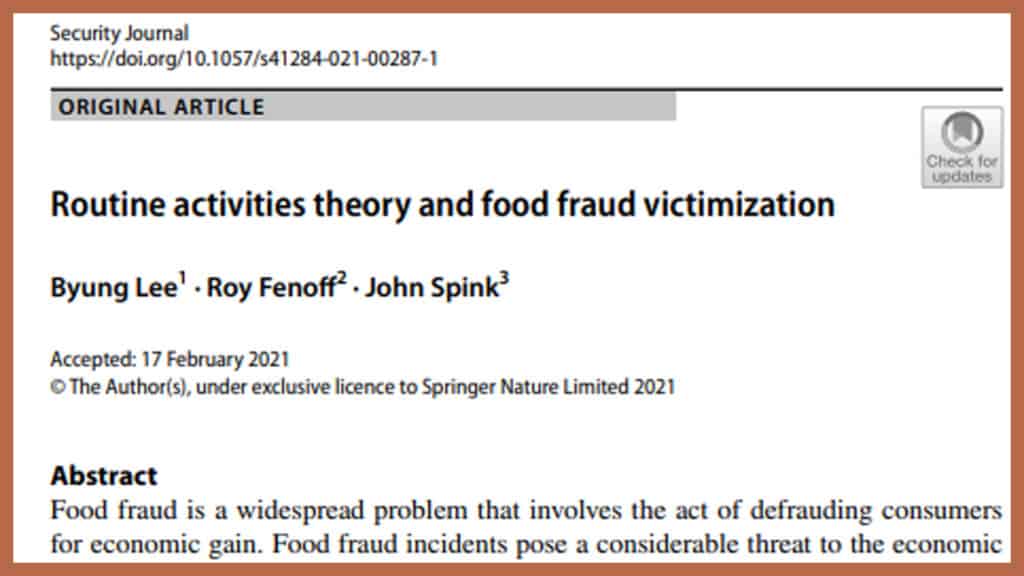Are consumers setting themselves up to get defrauded? (Yes.) Can the food industry modify food fraud prevention strategies to help consumers avoid get cheated? (Yes.) With two of my Criminology professor colleagues, we explored in this new article “routine activities” theory to strengthen “the role consumers play in food fraud prevention.”
- Byung LEE, Roy FENOFF & John SPINK. Routine activities theory and food fraud victimization. Security Journal (2021). Published On-line: March 9, 2021.
URL: https://link.springer.com/article/10.1057/s41284-021-00287-1
Our scholarly journal research article was published recently in Security Journal (Scopus listed impact factor SJR ranking = 0.463, CiteScore = 2.3, 85% percentile for 97/685 journals, subject area = Law.) This was a consumer survey that used traditional social science and criminology methods to gather a representative sample of the population. The five primary areas of focus were:
- Online routine activities. Prior studies on fraud victimization have explored a number of online activities as contributing factors for victimization.
- Online target suitability was conceptualized as an individual’s level of disclosure of personal information via the Internet.
- Exposure to food advertisements. Previous studies have shown that being exposed to food advertisements or promotion could induce an individual to consume food products.
- Perceived risk of victimization was assessed by asking respondents to rate the likelihood of being victimized by food fraud in the following year.
- Individual characteristics. Seven sociodemographic variables were included in the analyses.
Results
Of the five variables of online target vulnerability, two were significant:
First: There is increased vulnerability from having a very active, public, online profile. From online profiles, the consumer’s personal email and mobile phone information can be gathered and used for fraudulent direct marketing.
“Those who spend time personalizing their profile page or account are 2.2 times more likely to be victimized via food fraud. From an offender’s point of view, access to personalized information (e.g., email address, social media account, and mobile number) would be an adequate starting point for launching attacks against individuals and businesses. Specific software programs allow efficient collection of personal data, create fake profiles, and send friend requests.”
Second: Frequent online purchases through discount portals or chat apps can trigger fraudulent offers.
“Our findings indicate that purchasing food products online, using chatting apps, and personalizing one’s profile page constitute risky activities that influence opportunities for food fraud. Making frequent purchases of food products over vendor websites and being exposed to various sale alerts (e.g., coupons, discount offers) via chatting apps could make consumers more vulnerable to food fraud.”
Also, the most significant insight for a food fraud prevention strategy is that: Consumers are overconfident in their ability to detect and avoid fraud.
“One’s perception of food fraud risks does not necessarily indicate that an individual is competent in identifying and using effective strategies to prevent victimization.”
Most of the food fraud prevention focus is by the food industry reducing their supply chain fraud opportunity. This research expands the understanding of how the consumers get deceived. By understanding specifically how consumers are deceived, the countermeasures and control systems can be modified for maximum impact.
Reference – Related Springer/ Criminology articles:
URL: https://link.springer.com/search?query=spink&search-within=Journal&facet-journal-id=41284
Routine activities theory and food fraud victimization: Food fraud is a widespread problem that involves the act of defrauding consumers for economic gain. Food fraud incidents pose a considerable threat to the economic stability of agri-food industry as well as th…, Byung Lee, Roy Fenoff, John Spink in Security Journal (2021)
Product fraud and product counterfeiting as a source of terrorist financing: This short contribution is a complementary addition that addresses unexplored aspects of our recent Security Journal article When Crime Events Defy Classification: The Case of Product Counterfeiting as White-Coll…, John Spink in Security Journal (2017)
When crime events defy classification: The case of product counterfeiting as white-collar crime: By most accounts, product counterfeiting, a specific type intellectual property crime, is growing in scope, scale and threat and poses serious economic, social and public health harms. In this article, we impr…, Justin A Heinonen, John Spink, Jeremy M Wilson in Security Journal (2017)
Development of a product-counterfeiting incident cluster tool: There is growing awareness of the increasing scope, scale, and threat of product counterfeiting. Awareness is also growing for the drafting of countermeasures that specifically address deceptive and non-deceptive…,John Spink, Douglas C Moyer, Hyeonho Park, Justin A Heinonen in Crime Science (2014)
Defining the types of counterfeiters, counterfeiting, and offender organizations: Product counterfeiting is growing in scope, scale, and threat. This includes awareness of deceptive and non-deceptive counterfeiting types. (This paper does not consider copyright or digital piracy, currency…, John Spink, Douglas C Moyer, Hyeonho Park, Justin A Heinonen in Crime Science (2013)

